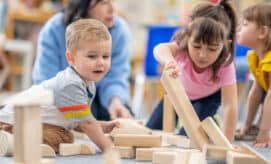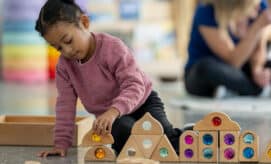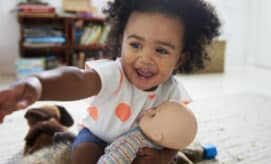During early childhood, valuable life skills are built through activities that combine play with learning. Children have a natural interest in engaging in playful activities that encourage them to communicate with peers, solve problems, and explore new ideas. Educators can facilitate and deepen early learning and skill-building by facilitating guided play.
In this article, we describe guided play and share ideas for incorporating the best of unstructured free play with the joy of learning.
Defining Guided Play
At the heart of play is fun. We are engaged in play when we are engaged in activities and experiences that we find joyful or interesting. Play can involve creating, pretending, building, experimenting, and more.
NAEYC explains that guided play “maintains the joyful child-directed aspects” of regular play, while adding “an additional focus on learning goals through light adult scaffolding…it features two crucial elements: child agency (the child directs the learning) and gentle adult guidance to ensure that the child progresses toward the learning goal.” Guided play is a powerful tool for educators to use in early childhood classrooms, because of the way that it supports critical academic and social-emotional skill development in a fun and engaging way.
What Does Guided Play Look Like?
Some educators can find it difficult to implement guided play into their teaching practice. Finding the right balance between structure and free play can sound tricky, but with everyday practice, it can become an intuitive component of work with young children.
PBS Kids explains that there are two ways that guided play can work:
-
Adults can create educational settings for children to freely explore on their own. This is similar to what we do every day in our classrooms by thoughtfully selecting materials and arranging the environment to support children in their learning. By offering materials that are engaging, challenging, and developmentally appropriate, educators create play settings that facilitate exploring, learning, and skill-building.
-
Adults can allow children to start playing as they naturally would, and then engage in that play along with them. This form of guided play is even easier, as it allows children to really lead the way and create experiences that are fun and interesting to them. As children play, educators can ask questions about what they are doing, share observations of their work, and offer explanations when children have questions or need support. As we engage with young children, we can help to expand on their play by encouraging them to think more deeply about their experiences: “Why do you think this happened?” or “What do you think might happen if we do this?”
Guided Play Supports The Developing Brain
When educators support children in their play, they are facilitating early neuron connections and foundational skill-building that will set children up for success when they transition to elementary school. For example, children develop language skills when they communicate with adults about play activities by asking questions and talking through their ideas. During conversations with adults, children also learn new words and expand their vocabulary.
When we ask children questions during their play, it helps them develop higher order thinking skills, such as thinking critically, solving problems, and expressing ideas. NAEYC notes that this kind of play can “help children develop what scientists call proactive control: neural mechanisms in the brain’s prefrontal cortex that use clues from the environment to help the brain figure out what might happen next.”
Additional Resources
If you are interested in learning more about guided play, you might enjoy the following resources:
-
Guided Play: Principles and Practices– an article from Carnegie Mellon University that describes guided-play situations that have been implemented successfully, and provides evidence linking guided play to student success.
-
Guided Play with Roberta– a video from Sesame Street in Communities with Dr. Roberta Golinkoff, a professor of education and director of the Child’s Play, Learning, and Development Laboratory, who shares insights into guided play and strategies for extending children’s learning, playfully.





